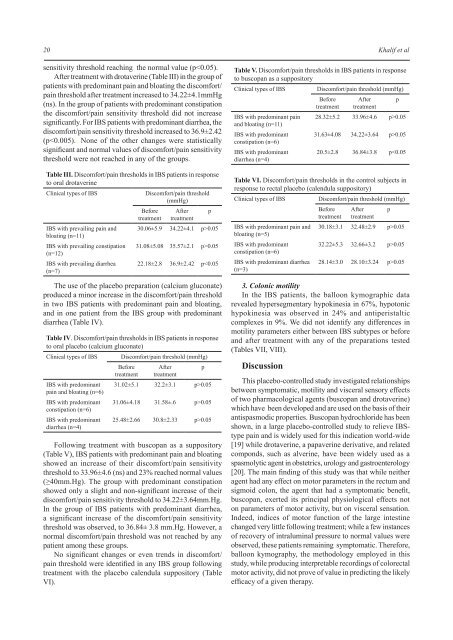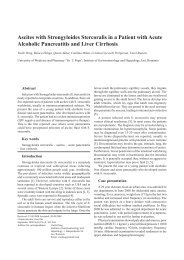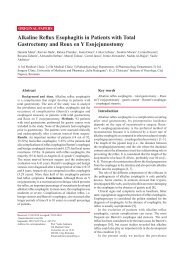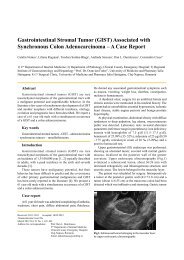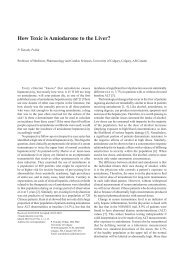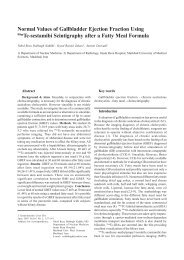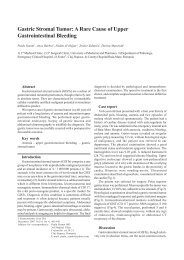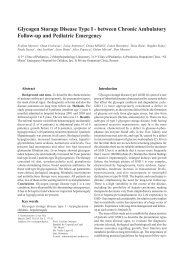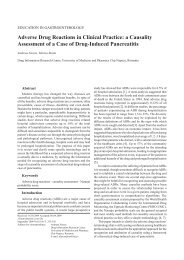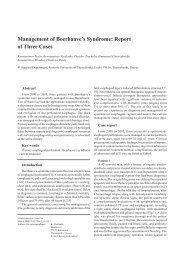download Full Article (PDF file) - Journal of Gastrointestinal and ...
download Full Article (PDF file) - Journal of Gastrointestinal and ...
download Full Article (PDF file) - Journal of Gastrointestinal and ...
Create successful ePaper yourself
Turn your PDF publications into a flip-book with our unique Google optimized e-Paper software.
20<br />
sensitivity threshold reaching the normal value (p0.05<br />
22.18±2.8 36.9±2.42 p0.05<br />
31.06±4.18 31.58±.6 p>0.05<br />
25.48±2.66 30.8±2.33 p>0.05<br />
Following treatment with buscopan as a suppository<br />
(Table V), IBS patients with predominant pain <strong>and</strong> bloating<br />
showed an increase <strong>of</strong> their discomfort/pain sensitivity<br />
threshold to 33.96±4.6 (ns) <strong>and</strong> 23% reached normal values<br />
(≥40mm.Hg). The group with predominant constipation<br />
showed only a slight <strong>and</strong> non-significant increase <strong>of</strong> their<br />
discomfort/pain sensitivity threshold to 34.22±3.64mm.Hg.<br />
In the group <strong>of</strong> IBS patients with predominant diarrhea,<br />
a significant increase <strong>of</strong> the discomfort/pain sensitivity<br />
threshold was observed, to 36.84± 3.8 mm.Hg. However, a<br />
normal discomfort/pain threshold was not reached by any<br />
patient among these groups.<br />
No significant changes or even trends in discomfort/<br />
pain threshold were identified in any IBS group following<br />
treatment with the placebo calendula suppository (Table<br />
VI).<br />
p<br />
p<br />
Khalif et al<br />
Table V. Discomfort/pain thresholds in IBS patients in response<br />
to buscopan as a suppository<br />
Clinical types <strong>of</strong> IBS<br />
IBS with predominant pain<br />
<strong>and</strong> bloating (n=11)<br />
IBS with predominant<br />
constipation (n=6)<br />
IBS with predominant<br />
diarrhea (n=4)<br />
3. Colonic motility<br />
In the IBS patients, the balloon kymographic data<br />
revealed hypersegmentary hypokinesia in 67%, hypotonic<br />
hypokinesia was observed in 24% <strong>and</strong> antiperistaltic<br />
complexes in 9%. We did not identify any differences in<br />
motility parameters either between IBS subtypes or before<br />
<strong>and</strong> after treatment with any <strong>of</strong> the preparations tested<br />
(Tables VII, VIII).<br />
Discussion<br />
Discomfort/pain threshold (mmHg)<br />
Before<br />
treatment<br />
After<br />
treatment<br />
28.32±5.2 33.96±4.6 p>0.05<br />
31.63±4.08 34.22±3.64 p>0.05<br />
20.5±2.8 36.84±3.8 p0.05<br />
32.22±5.3 32.66±3.2 p>0.05<br />
28.14±3.0 28.10±3.24 p>0.05<br />
This placebo-controlled study investigated relationships<br />
between symptomatic, motility <strong>and</strong> visceral sensory effects<br />
<strong>of</strong> two pharmacological agents (buscopan <strong>and</strong> drotaverine)<br />
which have been developed <strong>and</strong> are used on the basis <strong>of</strong> their<br />
antispasmodic properties. Buscopan hydrochloride has been<br />
shown, in a large placebo-controlled study to relieve IBStype<br />
pain <strong>and</strong> is widely used for this indication world-wide<br />
[19] while drotaverine, a papaverine derivative, <strong>and</strong> related<br />
componds, such as alverine, have been widely used as a<br />
spasmolytic agent in obstetrics, urology <strong>and</strong> gastroenterology<br />
[20]. The main finding <strong>of</strong> this study was that while neither<br />
agent had any effect on motor parameters in the rectum <strong>and</strong><br />
sigmoid colon, the agent that had a symptomatic benefit,<br />
buscopan, exerted its principal physiological effects not<br />
on parameters <strong>of</strong> motor activity, but on visceral sensation.<br />
Indeed, indices <strong>of</strong> motor function <strong>of</strong> the large intestine<br />
changed very little following treatment; while a few instances<br />
<strong>of</strong> recovery <strong>of</strong> intraluminal pressure to normal values were<br />
observed, these patients remaining symptomatic. Therefore,<br />
balloon kymography, the methodology employed in this<br />
study, while producing interpretable recordings <strong>of</strong> colorectal<br />
motor activity, did not prove <strong>of</strong> value in predicting the likely<br />
efficacy <strong>of</strong> a given therapy.<br />
p<br />
p


